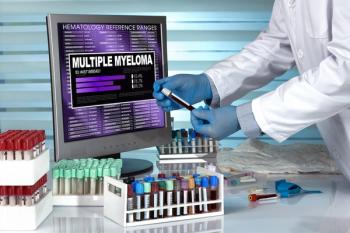
Beat AML Master Trial Expands Precision Medicine Options for Patients With AML: Ashley Yocum, PhD
At the European Hematology Association (EHA) 2025 Congress, Ashley Yocum, PhD, highlights how the Beat AML Master Trial advances safe, personalized treatment and expands targeted therapy options for patients with acute myeloid leukemia (AML).
In an interview at the
This conversation helps set the stage for the abstract
This transcript was lightly edited; captions were auto-generated.
Transcript
Can you briefly describe the background and goals of the Beat AML Master Trial?
Beat AML is a master protocol that assigns patients personalized treatment based on targeted genomic sequencing and local cytogenetics within 7 days. This trial started in 2016, with the main goal of assigning patients treatment within 7 days to see if it was safe. We easily did this with the first run-in analysis, and this has been
First, we discovered it was safe for patients to wait the 7 days to receive their targeted treatment and the more specific genomics of their AML disease. Second, we found that patients who were assigned a targeted treatment and received it did better than patients who received the standard of care, azacitidine. Thirdly, we have found that it is OK for patients to not receive treatment. These patients who could wait 7 days had time to reassess their disease and how they wanted to live the rest of their lives. We did see a percentage of patients opt not to receive treatment.
Since AML was normally treated on the same day, these were some pretty significant findings to show that it's OK to wait 7 days to receive that precision medicine treatment to have overall increased survival.
What have been the key accomplishments of the trial so far, and how have they shaped the current thinking around precision medicine in AML?
The AML landscape has changed a lot since this program started in 2016. We've seen targeted approvals for FLT3, IDH1, IDH2, among others. We also saw a big change with the approval of the standard of care for unfit patients, venetoclax and azacitidine. We saw that this increased overall survival for the patients, 14.7 months, compared [with] 9 months with azacitidina alone. This is a good treatment for patients. However, it's not curative, and it's not ideal. Venetoclax has myelosuppression, leading to cytopenias, as well as other toxicities for patients, so a lot of patients do not stay on the treatment very long.
Currently, Beat AML is sponsoring the first LLS [Leukemia & Lymphoma Society]–sponsored clinical trial, which we call optiAML. We're investigating whether a shorter duration of venetoclax of 14 days, compared [with] the label 28 days, will still get the same amount of responses. That is the primary objective of that study, so we're doing that. We have over 80% of patients enrolled, and we anticipate having this data by the end of the year.
Also, what we're looking at [as] secondary objectives for the study is to see if there is an increase in the safety profile, to also look at the duration of the cycles, and to look for decreased hospitalization stays, as well as decreased infections, which are also very common with VEN+AZA [venetoclax plus azacitidine] treatments.
Other successes that we have had with the Beat AML Master Trial has been that we have opened over 15 studies for targeted treatments for patients. One of our substudies was accepted into the NCCN [National Comprehensive Cancer Network] guidelines, and that's inacitinib into the front-line treatment for patients with IDH2 mutations. This drug is approved for relapsed/refractory patients, not for newly diagnosed. This is a great win for us and our patients. When treatments are in the NCCN guidelines, this helps patients get access to them, as well as to get insurance coverage, which is a big win for the Leukemia & Lymphoma Society, as well as for Beat AML.
We've also had some other victories, as well. We had 2 studies go forward with the data that they generated on our phase 2 studies and phase 1 to be able to do registrational phase 3 studies. One of these studies has been highlighted here at EHA this year with a presentation that was given on Thursday by our Dr Josh Zeidner.
Reference
1. Burd A, Levine RL, Ruppert AS, et al. Precision medicine treatment in acute myeloid leukemia using prospective genomic profiling: feasibility and preliminary efficacy of the Beat AML Master Trial. Nat Med. 2020;26(12):1852-1858. doi:10.1038/s41591-020-1089-8
Newsletter
Stay ahead of policy, cost, and value—subscribe to AJMC for expert insights at the intersection of clinical care and health economics.













































